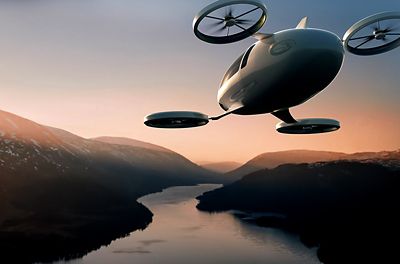ANSYS ADVANTAGE MAGAZINE
October 2021
As an engineering mechanics student at China’s Zhejiang University, Dr. Yu Feng developed an early, and unusual, interest in health care applications.
“Most of my fellow students were fascinated by turbines and aerospace science,” he recalls. “But I was more intrigued by the mechanics of the human body, particularly the respiratory system.” As early as 2007, Feng was usingAnsys Fluentto perform computational fluid dynamics (CFD) simulations of air trajectories inside the lungs as part of his undergraduate research. He continued this work while earning his master’s and doctoral degrees in mechanical engineering at North Carolina State University.
Fast forward to 2021, when Feng has become a pioneer of using engineering simulation ― including both CFD and structural modeling ― to create digital twins of the respiratory systems of individual human patients. His team at the Computational Biofluidics and Biomechanics Laboratory at Oklahoma State University is working to gain a more in-depth understanding of respiratory processes and improve pulmonary health outcomes, a topic that’s gained global attention today.
“Simulation provides a noninvasive way to understand the geometry and mechanics of each patient’s respiratory tract, making treatments more targeted and more effective,” he notes. “My entire academic and professional career has been based on using simulation to improve human respiratory health, and theCOVID-19 pandemichas only increased my commitment.”
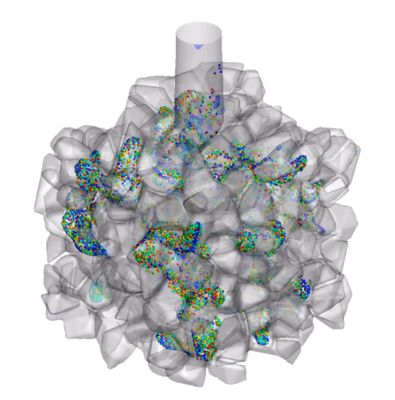
Feng’s geometric models of the human respiratory system extend all the way from the mouth to the alveoli, the tiny fluid-filled sacs in the lung that support gas exchange. His work is elucidating how both toxic and therapeutic particles are absorbed via fluid-structure interactions. (Thank you to Dr. Kenichiro Koshiyama, Tokushima University, Tokushima, Japan, for the code generating the alveoli geometry.)
More Accurate Tracking of Toxic and Therapeutic Particles
In his research group in the School of Chemical Engineering at Oklahoma State, Feng uses Fluent andAnsys Mechanicalto construct a subject-specific complete respiratory model, covering the entire lung-conducting zone that begins with the mouth. Feng’s simulations incorporate computational fluid-particle dynamics (CFPD) and physiologically based pharmacokinetic/toxicokinetic (PBPK/TK) models to capture the transportation, deposition, translocation and clearance of inhaled aerosols in the pulmonary system. Feng’s dynamic simulations are among the first to capture the complex workings of the human respiratory tract as it is exposed to airborne particles.
By modeling the whole-lung geometry and then creating a dynamic digital simulation, Feng can gather high-resolution data and perform parametric studies that show how particles are distributed and absorbed over time. Not only can this advanced research improve the effectiveness of inhalers and other respiratory therapies, but it can also help illuminate how the coronavirus and other airborne diseases enter the lungs.
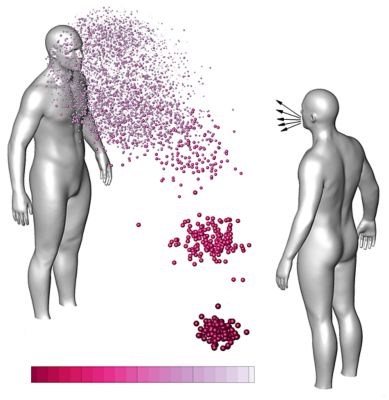
By using simulation to model the pathways of airborne particulates following a cough, Feng and his research team are increasing the collective understanding of how COVID-19 and other airborne diseases are transmitted.
“肺通过Ansys软件建模可以帮助clinicians better understand and visualize particle flows, so they can design more effective devices and treatment plans for delivering drug therapies to the lungs, no matter the patient’s respiratory condition,” explains Feng. “In terms of combatting COVID-19 and other airborne illnesses, these simulations can also help elucidate how viruses attach to the lung, grow and trigger an immune-system reaction.”
Feng’s research team at Oklahoma State is also using dynamic simulations to increase the collective understanding of how the coronavirus is transmitted in both indoor and outdoor environments. By revealing how airborne particles travel, and the effects of ventilation systems on their pathways, Feng hopes to protect health care workers and the general public from airborne infections and pollution.
Patient-Specific Digital Twins: An Emerging Concept
根据Thierry Marchal, program director forHealthcare Solutionsat Ansys, one of the most exciting aspects of Feng’s models is the fact that they can be customized to reflect the exact geometries of a specific patient.
“Dr. Feng’s work on customized human-body simulation is at the forefront of medical research and development today,” Marchal emphasizes. “The global health care community is recognizing that a personalized approach to drug delivery, surgery and other medical interventions can deliver dramatically improved outcomes.”
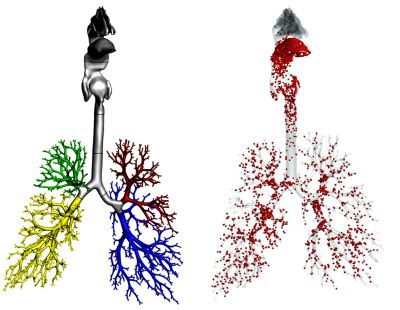
In his lab at Oklahoma State, Yu Feng is using fluid-structureinteraction simulations to understand how the human airway is impacted by obstructions in various locations ― and how each of those obstructions might affect air flows and treatment plans.
How exactly does Feng’s modeling approach impact patient results? Consider a patient with a very specific deformity in the respiratory tract, such as a scarred glottis that partially impedes the airway. By using inputs from CT images, MRI scans or other imaging methods to create a base geometry in Ansys Mechanical, Feng can model this very specific deformity. Then he can add Fluent to build a digital twin that dynamically replicates real-world airflows, all the way from the mouth to the alveoli, the tiny sacs in the lungs. Expanding Fluent capabilities by adding PBPK/TK models, Feng can next predict how the particles are absorbed through the alveola wall and distributed through the organs.
Clinicians can study fluid-structural interactions (FSIs) in the digital twin to see how this patient-specific feature affects the individual’s overall breathing process, as well as the delivery of therapeutic drugs to the lungs. Then they can modify their treatment plans accordingly.
“In improving medical outcomes for all patients, the question is not, ‘How can we make a better one-size-fits-all inhaler or ventilator?’” says Feng. “The question is, ‘How can we engineer an inhaler or ventilator, and associated best practices, that work more effectively for specific patients?’ Dynamic, multiphysics simulations are the most noninvasive and cost-effective way to accomplish that goal.”
While the concept of human digital twins is not widely deployed today, Feng’s research is creating a foundation for broader adoption. He is collaborating with doctors at the University of Oklahoma Health Sciences Center to perfect the simulation models and algorithms that underlie his digital twins so they can eventually be commercialized and launched on a large scale.
Breathing New Life into Respiratory Therapies
A 13-year user of Ansys simulation software, Feng points out that today’s dynamic digital twins would not be practical without significant advances in processing speeds, parametric studies and computational algorithms that deliver faster solve times. Because the human respiratory tract is geometrically complex, and dynamic particulate-based airflows are equally complex, Feng’s work involves solving problems that are extremely large numerically.
“从Ansys Workbench的开发数据management, which allows my team to apply machine-learning algorithms to an enormous database, to the emergence of cloud hosting, Ansys has supported my research as it’s grown in complexity,” states Feng. “Everything Ansys has done to improve its software has directly benefited my modeling capabilities and increased the likelihood that they can be launched into the global health care market.”
Dr. Yu Feng has come a long way from his early days as an engineering mechanics undergraduate who was fascinated by the human respiratory system. Today he is leading the development of innovative diagnostic and therapeutic approaches that have the potential to transform health care ― and help the world win its battle against COVID-19 and other airborne illnesses.
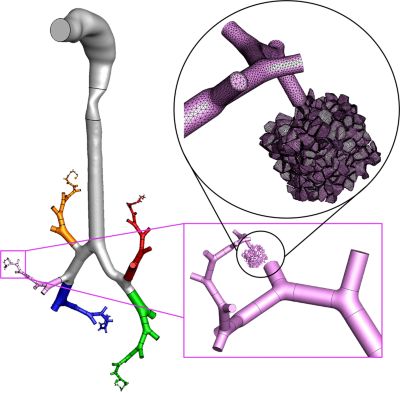
Feng’s work is advancing clinicians’ ability to develop patient-specific treatment plans. Here, Feng models a glottis that is deformed. By creating a digital twin that includes this deformity, Feng reveals how it will impact the lungs’ ability to absorb medications or oxygen when administered in a health care setting.












